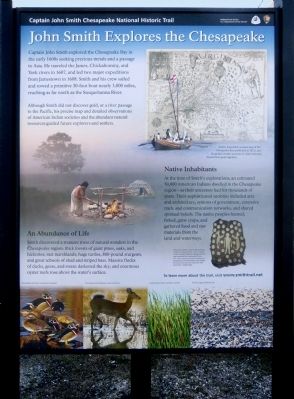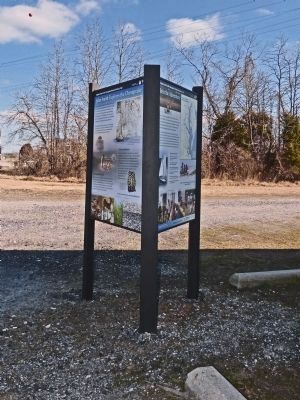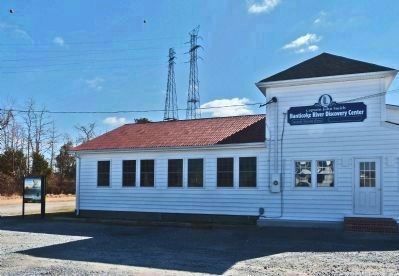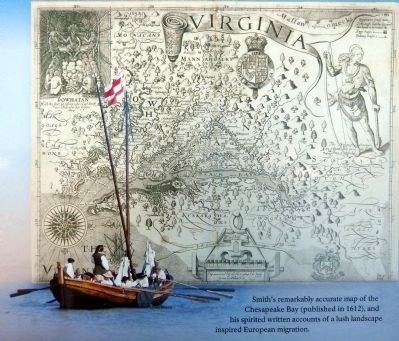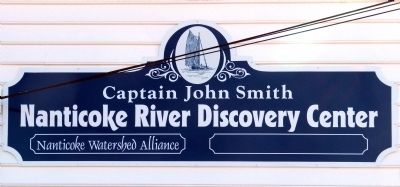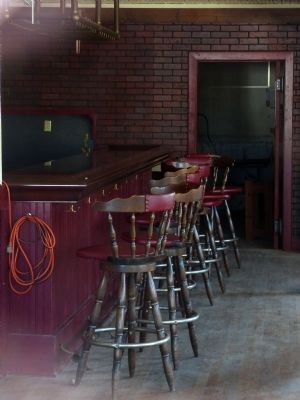Vienna in Dorchester County, Maryland — The American Northeast (Mid-Atlantic)
John Smith Explores the Chesapeake
Captain John Smith Chesapeake National Historic Trail
Captain John Smith explored the Chesapeake Bay in the early 1600s seeking metals and a passage to Asia. He traveled the James, Chickahominy, and York rivers in 1607, and led two major expeditions from Jamestown in 1608. Smith and his crew sailed and rowed a primitive 30-foot boat nearly 3,000 miles, reaching as far north as the Susquehanna River. Although Smith did not discover gold, or a river passage to the Pacific, his precise map and detailed observations of American Indian societies and the abundant natural resources guided future explorers and settlers.
Native Inhabitants
At the time of Smith's explorations an estimated 50,000 American Indians dwelled in the Chesapeake region -- as their ancestors had for thousands of years. Their sophisticated societies included arts and architecture, systems of government, extensive trade and communication networks, and shared spiritual beliefs. The native peoples hunted, fished, grew crops, and gathered food and raw materials from the land and waterways.
An Abundance of Life
Smith discovered a treasure trove of natural wonders in the Chesapeake region: thick forests of giant pines, oaks, and hickories; vast marshlands; huge turtles, 800-pound sturgeon, and great schools of shad and striped bass. Massive flocks of ducks geese, and swans darkened the sky; and enormous oyster reefs rose above the water's surface.
Topics and series. This historical marker is listed in these topic lists: Colonial Era • Exploration • Native Americans. In addition, it is included in the Captain John Smith Chesapeake National Historic Trail series list. A significant historical year for this entry is 1607.
Location. 38° 29.125′ N, 75° 49.418′ W. Marker is in Vienna, Maryland, in Dorchester County. Marker is on Middle Street. The marker is in front of the Nanticoke Discovery Center, home of the Nanticoke Watershed Alliance. Touch for map. Marker is at or near this postal address: 1 Middle Street, Vienna MD 21869, United States of America. Touch for directions.
Other nearby markers. At least 8 other markers are within 2 miles of this marker, measured as the crow flies. Discover: Vienna Heritage (about 700 feet away, measured in a direct line); A walking tour of Vienna (about 700 feet away); Discover: Restoration (approx. 0.2 miles away); Discover: The Nanticoke (approx. 0.2 miles away); Discover: Vienna (approx. 0.2 miles away); Discover: The Shoreline (approx. ¼ mile away); Unnacokossimmon (approx. ¼ mile away); The Nanticoke Historic Preservation Alliance (approx. 1.7 miles away). Touch for a list and map of all markers in Vienna.
Also see . . .
1. Captain John Smith Chesapeake National Historic Trail. National Park Service website entry (Submitted on February 15, 2013, by Allen C. Browne of Silver Spring, Maryland.)
2. A Digital Historical Geography of Vienna, Maryland:. The Digitization of John Smith’s 1612 Map of the Chesapeake Bay and Thomas Ennals’ 1706 Map of “Vienna Towne” by Michael S. Scott, PhD (Submitted on February 16, 2013, by Allen C. Browne of Silver Spring, Maryland.)
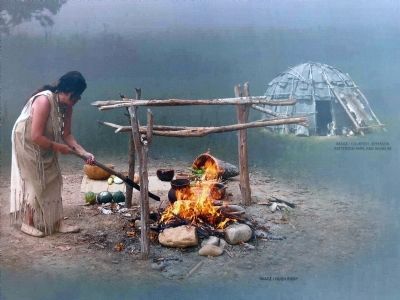
Photographed By Allen C. Browne, February 9, 2013
5. Native Inhabitants
At the time of Smith's explorations an estimated 50,000 American Indians dwelled in the Chesapeake region -- as their ancestors had for thousands of years. Their sophisticated societies included arts and architecture, systems of government, extensive trade and communication networks, and shared spiritual beliefs. The native peoples hunted, fished, grew crops, and gathered food and raw materials form the land and waterways.(Image by Hugh Rigby, courtesy Jefferson Patterson Park and Museum.
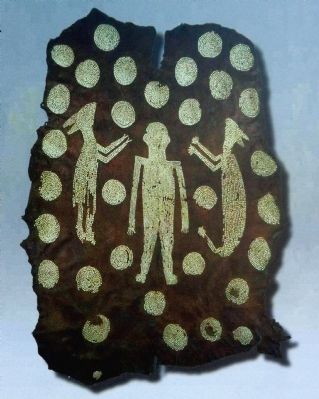
Photographed By Allen C. Browne, February 9, 2013
6. Ceremonial Robe
Decorative shells -- such as those found on this ceremonial robe -- were valuable in the American Indian's tradeing network that extended for hundreds of miles. This robe (which may have belonged to paramount chief Powhatan) was crafted from elk skins and adorned with more than 17,000 shells.
Credits. This page was last revised on May 13, 2022. It was originally submitted on February 15, 2013, by Allen C. Browne of Silver Spring, Maryland. This page has been viewed 587 times since then and 11 times this year. Photos: 1, 2, 3, 4, 5, 6, 7, 8. submitted on February 15, 2013, by Allen C. Browne of Silver Spring, Maryland. 9. submitted on February 16, 2013, by Allen C. Browne of Silver Spring, Maryland. • Bill Pfingsten was the editor who published this page.
